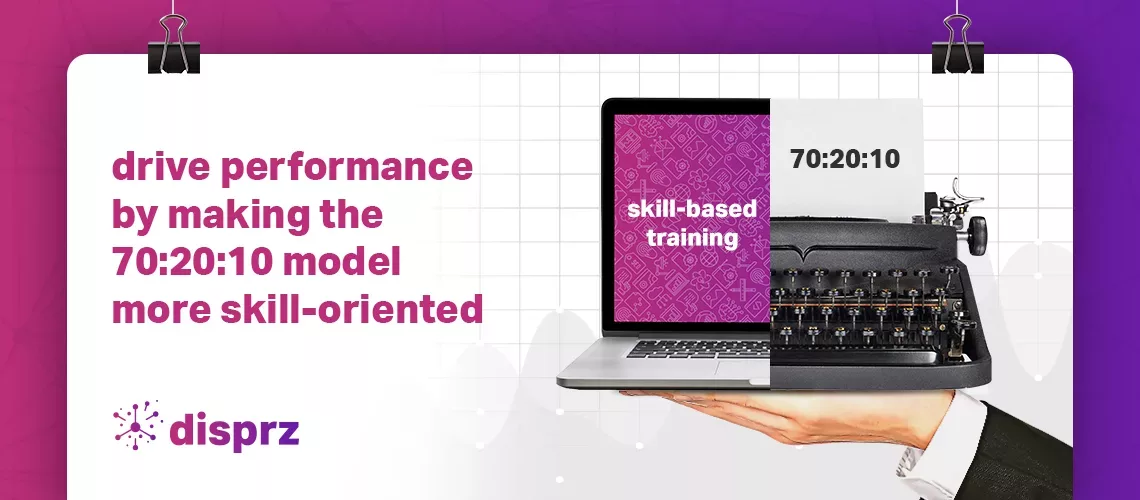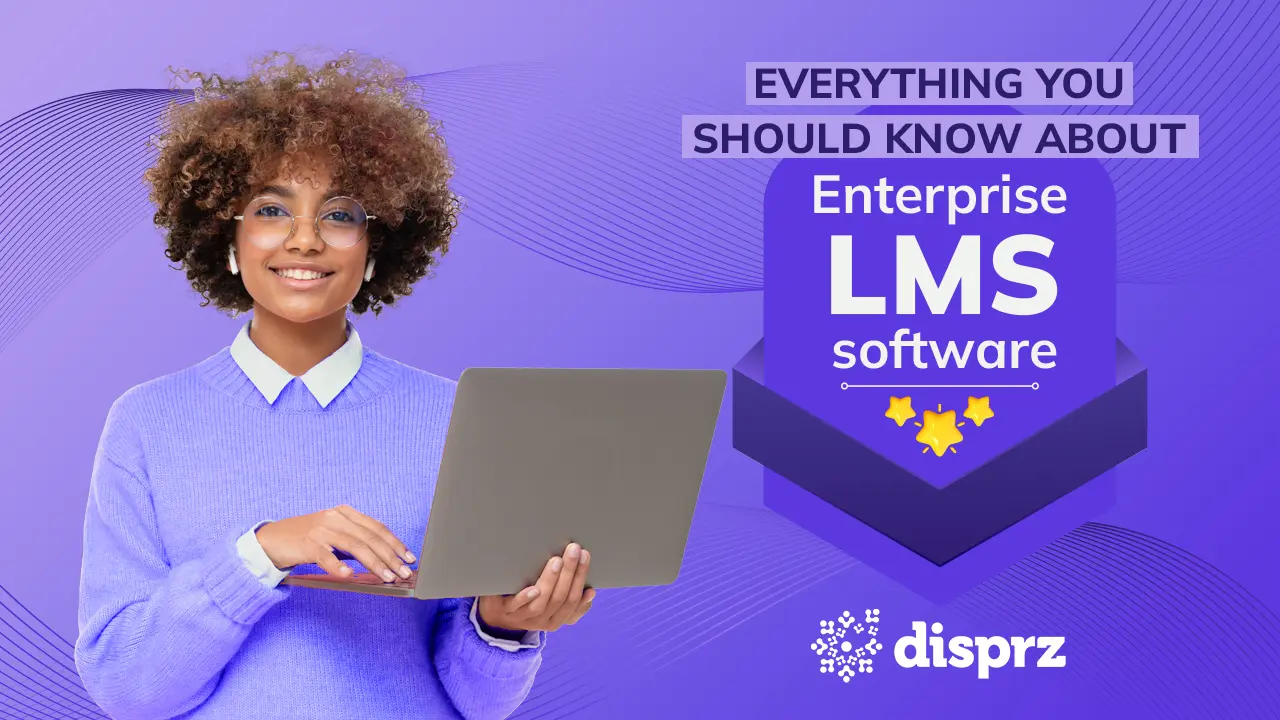
6 min read
• 22 Sep 2023
70 20 10 Learning Model for Enhanced Learning and Development
Discover how the 70 20 10 learning model can boost the success of your L&D initiatives and maximize employee learning outcomes for your organization.
-
eBookEmployee Upskilling - A Detailed Blueprint For Building A Skills-Driven Learning Culture
Over the past few decades, the 70:20:10 learning model has gained significant attention from CLOs and L&D professionals. This model has been regarded as highly valuable for companies striving to optimize the impact of their learning and development initiatives.
The 70-20-10 learning model is undoubtedly effective, but it requires a fresh approach when it comes to upskilling your employees. Ironically, many teams and leaders still struggle to seamlessly integrate this model into their L&D strategy, as traditional implementation approaches fall short of delivering expected results. Making a shift towards skill-based training can provide a positive direction for harnessing the full potential of the 70-20-10 learning model.
Before we get to the new approach, let’s dive deep into the basics first.
What is the 70-20-10 learning model?
The 70-20-10 learning model proposes that employees learn most effectively when exposed to a variety of combined learning experiences. Despite its mathematical terminology, 70:20:10 is not a precise formula for success, but rather a guideline for how much weight to devote to each area.
The model's goal is to encourage leaders, managers, and team members to perceive learning and development (L&D) as an integral part of their everyday roles, rather than an optional extra or something reserved for the L&D department.
The framework of this model is broken down to:
- 70% of learning happens through on-the-job experience.
- 20% of learning happens through social interactions
- 10% of learning happens through formal learning
While historically, this model has been extremely effective, digital acceleration and the ever-changing market space demand a skill-based approach to tackle business challenges. For this reason, the traditional model requires modernization and a greater emphasis on skill development to upskill and reskill your employees in the digital-first era.
Why Use the L&D Model?
Incorporating an effective L&D model can be a strategic advantage for businesses, helping them stay competitive, innovative, and attractive to both customers and top talent.
Here are the key reasons behind using the L&D model
Enhanced Employee Skills: The L&D model provide structured training and development opportunities for employees. This leads to improved skills, knowledge, and expertise, which can boost their performance and productivity.
Increased Employee Engagement: When companies invest in the growth and development of their employees, it fosters a sense of value and loyalty. Engaged employees are more likely to stay with the organization, reducing turnover and its associated costs.
Adaptation to Industry Changes: Industries are constantly evolving. The L&D model ensures that employees are up-to-date with the latest industry trends, technologies, and best practices, making the company more adaptable to changes and competitive in the market.
Talent Development and Retention: The L&D model serves as a powerful strategy for identifying and nurturing talent within the organization. By providing growth opportunities, companies can groom their employees for leadership roles, reducing the need to hire externally.
Improved Organizational Performance: Ultimately, a well-implemented L&D model leads to better overall organizational performance. Employees are equipped with the skills and knowledge to excel in their roles, contributing to the company's growth and success.
The importance of enhancing the 70-20-10 learning model with upskilling
The 70-20-10 learning model is popular due to its effectiveness in improving learning and development. Despite this, it has received criticisms, particularly around its lack of structure. The 70% ratio assigned to on-the-job experience has been a point of concern for many.
However, it’s important to remember that the 70-20-10 model is only a guideline and can be customized to meet an organization’s specific learning and development needs. With structured upskilling strategies, employees can direct their L&D efforts in a positive direction. By identifying and developing the necessary skills, employees can expand their capabilities and drive their performance.
How to enhance the 70-20-10 learning model
The 70-20-10 learning model emphasizes that various types of learning – experiential, social, and formal – are crucial for the success of your L&D initiative. As a flexible framework, the model can be readily integrated with skill-based training to align with your organization’s specific learning and development requirements.
Here is how skilling can be blended with the 70:20:10 model to drive impact.
Connect roles with essential skills
Modern companies are charting toward digital maturity; employees are propelled to take up new responsibilities amidst digital acceleration. Employees need more clarity on their roles and the capabilities they have to build to shape their career paths. Linking roles with skills can help provide a clearer picture to employees. For instance, if skills are defined for a digital marketing executive, assistant manager, and manager. The employee will know which skills they need to develop to do their job efficiently or move to the next role.
A skilling suite, like Disprz, helps in identifying and benchmarking skills for different roles in a company. It even enables managers and employees to measure the proficiency level for each skill.
For instance, on a scale of 1 to 10, the manager rates an employee 4 for a particular skill, and in self-assessment, the employee also rates himself 4, so his skill score will be 4.
Based on the skill score, the employee gets a clear understanding of how much effort he has to put in to build the skills for moving to the next role. So accordingly, he can coordinate with employees who are experts in a particular skill. He can self-enroll in various courses and practice what he has learned to get better at a particular skill. Here the employee is still doing experimental learning, but it is a more streamlined way.
Read how Petronas leveraged Disprz LXP to tailor individualized development paths for each role.
Upskill through peer-generated content and employee engagement
Once the skills are defined for a specific role, employees can collaborate and learn together. For instance, there are three sales executives in a team, and the skills are benchmarked for the sales executive role. Through a skill assessment, they find out that all three are good at different skills; for instance, one is good at cold calling, the other is good at setting appointments, and the third is good at giving sales presentations. So all three can share the techniques that worked really well with each other.
The company can empower them by giving them the right learning tool with a social platform where they can collaborate with peers, share valuable resources, and brainstorm together. Social learning aligned with a skill-driven approach can help boost engagement and results.
Read how Deloitte leverage Disprz LXP for AI-powered content recommendations, engaging social features and lot more.
Define a personalized learning pathway
The 10% of learning that is dedicated to formal training can also be skill-focused to derive better results. With the help of an LXP, the L&D can assess skills and create a personalized skilling journey for developing different skills.
Most of the LXP solutions are powered by AI that recommends relevant courses based on the learner’s skills and interests. This helps take personalization to the next level for developing necessary skills in real time.
Leverage Employee Upskilling Technology
The 70 20 10 learning model can be very effective today if given a skilling edge. Using the right skilling platform, L&D can identify, assess and build skills at scale. Disprz is one such skilling solution that can help blend the 70 20 10 model with skill-based training.
Disprz LXP gives employees the flexibility to explore skills that interest them, all while driving learning initiatives that seamlessly blend with the business goals. This powerful AI-based platform provides personalized and intelligent learning recommendations based on the job role, interest, skills, and the employees’ learning preferences.
Conclusion
While the 70-20-10 learning model has historically proven effective, its adaptation to the digital age requires a strong emphasis on skill-based training. Connecting roles with essential skills, fostering peer-generated content and collaboration, and leveraging personalized learning pathways are key to enhancing this model. Modern Learning Experience Platforms like Disprz play a crucial role in facilitating skill-focused learning, ensuring employees can develop the necessary capabilities in alignment with their roles and interests.
By integrating skill development into the 70-20-10 model, organizations can empower their workforce to excel in today's digital-first landscape, achieving both individual and organizational success.

About the author

Debashree Patnaik
Debashree is a seasoned content strategist at Disprz.ai, specializing in enterprise learning and skilling. With diverse experience in B2B and B2C sectors, including ed tech, she leads the creation of our Purple papers, driving thought leadership. Her focus on generative AI, skilling, and learning reflects her commitment to innovation. With over 6 years of content management expertise, Debashree holds a degree in Aeronautical Engineering and seamlessly combines technical knowledge with compelling storytelling to inspire change and drive engagement.
More Resources
4 min read
• 15 Apr 2024
Unlocking the Power of Managerial Engagement in Talent Development
4 min read
• 09 Apr 2024
Nurturing Excellence in Building Leadership Pipelines
Sign up to get free resources and stay up to date with Disprz!
Discover how Disprz can align learning and upskilling with your desired business outcomes.





